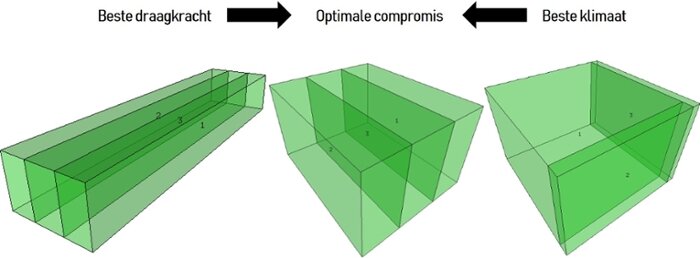
How can computers help design optimal buildings? Ph.D. student Koen van der Blom makes algorithms that take into account all kinds of different architectural requirements, in order to reach the best compromise. And that is quite difficult: "Algorithms do not automatically understand that a building that floats in the air is not practical."
The perfect balance
The design of buildings is usually developed by several experts from different architectural disciplines," says Van der Blom. "Every expert has his own requirements. The adjustments made by an expert in discipline A, who looks at the building's load-bearing capacity, may have a negative influence on discipline B, the temperature control." Van der Blom's algorithms should make it easier to optimize building designs for all these different requirements at an early stage. "They search for the perfect balance, which results in better designs. This also saves a lot of time: at a later stage, it takes much longer to adjust."
A complex problem
Designing these kinds of algorithms is quite complex. According to Van der Blom, this is due to several factors. "First of all, we are dealing with a so-called multi-criteria problem. This means that we have to find solutions that balance different requirements." Van der Blom looked at both structural design (such as load-bearing capacity and material saving) and the building-physical design (heating and cooling).
The second aspect is the mathematical representation of the problem. Van der Blom: "It consists of a combination of very different parts. In order to search each component efficiently at the same time, a complex combination of several search techniques was needed."
The last difficulty is dealing with restrictions. These restrictions are necessary to guarantee that the solutions found are usable and valid. "The algorithms do not understand by themselves what makes a building good or bad," explains Van der Blom. "As a result, without further instructions, they also try things that are strange to people. A building that floats in the air, for example, is not a problem for the computer, but we want to rule that out because it is practically impossible." Although such solutions are often not of high quality, and therefore do not end up as a final solution, it does take time to evaluate them. "So we exclude them to save time. We use the time gained to search through a larger number of valid buildings."
From simple algorithm to practice
The search for the right method started with standard algorithms. Van der Blom: "Then we looked step by step at what didn't work properly, for example searching through large numbers of invalid designs, and then we looked for a solution. By slowly adding complexity and knowing that the basis worked well, we were able to find a good solution for one new problem at a time."
Van der Blom worked together with structural engineers from the Eindhoven University of Technology. "We also tested our algorithms at an architectural firm (De Twee Snoeken). That was fairly positive: the algorithms work, but we still need to solve a number of practical problems before we can properly apply them in practice."
Citation: Building with algorithms: Looking for the optimal design (2019, December 9) retrieved 9 December 2019 from https://techxplore.com/news/2019-12-algorithms-optimal.html
This document is subject to copyright. Apart from any fair dealing for the purpose of private study or research, no part may be reproduced without the written permission. The content is provided for information purposes only.
